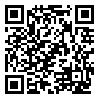Fri, Dec 26, 2025
[Archive]
Volume 22, Issue 1 (2012)
IJAUP 2012, 22(1) |
Back to browse issues page
Download citation:
BibTeX | RIS | EndNote | Medlars | ProCite | Reference Manager | RefWorks
Send citation to:



BibTeX | RIS | EndNote | Medlars | ProCite | Reference Manager | RefWorks
Send citation to:
memarian G, salehinia M. Sociopetaloid of Architecture Space Result of synthesis and synomorphy of humane-physical factors . IJAUP 2012; 22 (1)
URL: http://ijaup.iust.ac.ir/article-1-57-en.html
URL: http://ijaup.iust.ac.ir/article-1-57-en.html
1- , memarian@iust.ac.ir
Abstract:
This research experimentally analyzes the issue of Sociopetaloid of architecture space. Sociopetal represents spaces where
people come together or stay away from each other, and when they stay away from each other it is also called sociofugal.
The research methodology was primarily compiled by presenting a pattern with a theoretical standpoint regarding the
Sociopetaloid of space using hypothesis testing with a case study with the aid of polling, first on-site presence technique, then a
cognition map tool and a questionnaire.7 public spaces were selected amongst 3 distinguished independent the university of
science and technology(IUST) faculty buildings for the case study. The data underwent correlative analysis using the SPSS
statistical software and meaningful relations were determined between the variables affecting Sociopetaloid.
The following main results were achieved in this research:
• The psychological-social factors of users directly influenced the Sociopetaloid of the public architecture space and were
considered as an establisher.
• Physical-spatial factors influence Sociopetaloid. This influence has two types one with "direct affordance" and another with
"indirect affordance".
• Sociopetaloid of public space is achieved with proper synthesis of the spatial- physical elements of architecture and
psychological-social elements of users. This Sociopetaloid increases with a high synomorphy between the space physic and
interpersonal behaviors.
Keywords: Sociopetaloid, Architecture, Public space, Synthesis, Synomorphy, Humane- physical factors
Type of Study: Research Paper |
Subject:
General Architecture
| Rights and permissions | |
 | This work is licensed under a Creative Commons Attribution-NonCommercial 4.0 International License. |




